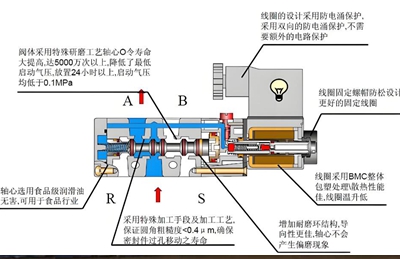Precautions and troubleshooting for
solenoid valve wiring
When wiring the solenoid valve, there are many precautions that need to be followed to ensure the normal operation of the solenoid valve and the safe operation of the system.
Firstly, it is necessary to ensure that the power supply voltage meets the requirements of the solenoid valve. Different models of solenoid valves have different rated voltage ranges. If the power supply voltage is too high, it may cause the solenoid valve coil to burn out; If the voltage is too low, the solenoid valve may not be able to open or close properly. For example, if a solenoid valve with a rated voltage of AC220V is connected to an AC380V power supply, the coil will quickly heat up and burn out due to overvoltage.
Secondly, it is important to select the wires correctly. Select appropriate wire specifications based on the power and wiring distance of the solenoid valve to ensure that the wire can carry sufficient current and avoid heating due to excessive current. At the same time, it is necessary to choose wires with good insulation performance to prevent leakage.
There are also some key points to pay attention to when installing
solenoid valves. The valve body usually has arrow markings, and the direction of the arrow should be consistent with the flow direction of the medium. The solenoid valve should be installed vertically upwards and should not be installed in areas with direct dripping or splashing water, nor should it be installed in low-lying areas of the pipeline to avoid obstruction of operation due to medium deposition.
In addition, necessary inspections and tests need to be conducted after the wiring is completed. Check whether the wiring is secure, whether there are exposed wires, use a multimeter to measure the insulation of the wires, and ensure that there are no short circuits or leakage phenomena. After connecting the power supply, observe the working status of the solenoid valve, listen for any normal operating sound, and check if the fluid can smoothly pass through the solenoid valve.
If the solenoid valve malfunctions, such as not functioning or acting abnormally, it needs to be investigated. Firstly, check if the wiring head is loose or if the wire head has fallen off. If there is any looseness, tighten the wire head. Secondly, measure the resistance of the solenoid valve coil with a multimeter. If the resistance value is infinite, it indicates that the coil may have been burned out and needs to be replaced. In addition, it is necessary to check whether the solenoid valve is stuck. The solenoid valve can be removed, the valve core and valve core sleeve can be taken out, and cleaned with CCI4 to make it move flexibly. At the same time, check whether the medium in the pipeline is clean, whether there are impurities blocking the solenoid valve, and whether a filter is installed in front of the valve. Only by properly wiring the solenoid valve and paying attention to daily maintenance and troubleshooting can we ensure the long-term stable operation of the solenoid valve and provide guarantees for the normal operation of the entire automation control system.

